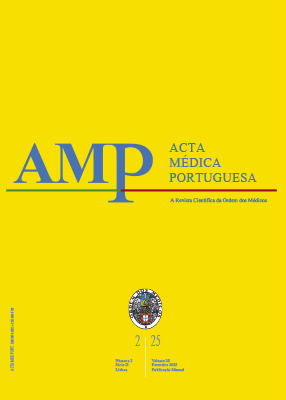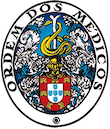Tradução e Adaptação Cultural do Questionário ISTH-Bleeding Assessment Tool para Português Europeu
DOI:
https://doi.org/10.20344/amp.22374Palavras-chave:
Distúrbios da Coagulação Sanguínea, Inquéritos e Questionários, Medidas de Resultados Reportadas pelo Doente, Portugal, TraduçãoResumo
Introdução: A identificação da história clínica completa da sintomatologia hemorrágica do doente é a primeira etapa no diagnóstico de qualquer coagulopatia congénita. Além disso, por se tratar de uma avaliação do fenótipo hemorrágico do doente, este não é (apenas) um método ou exame complementar de diagnóstico - é uma etapa essencial e intrínseca na definição da história clínica do doente, o que constitui um ato médico. O International Society on Thrombosis and Haemostasis-Bleeding Assessment Tool (ISTH-BAT) é um instrumento de avaliação da hemorragia padronizado, utilizado quando existe suspeita de doença hemorrágica. Este estudo teve como objetivo a tradução e adaptação cultural do questionário ISTH-BAT para o português europeu.
Métodos: A tradução e a adaptação cultural foram baseadas nas normas da International Society for Pharmacoeconomics and Outcomes Research e iniciadas após a obtenção da autorização dos autores da versão original. O processo envolveu três traduções independentes do inglês para o português europeu e uma retroversão. As discrepâncias foram gradualmente resolvidas. A versão traduzida conciliada foi apresentada a doentes com hemofilia e
portadoras de hemofilia para identificarem problemas de compreensão do questionário.
Resultados: As traduções diretas e reversa não mostraram discrepâncias importantes. No entanto, foram identificadas algumas questões nas entrevistas cognitivas, que levaram à adaptação cultural de termos médicos para uma melhor compreensão do questionário pelos doentes.
Conclusão: Um processo formal de tradução e adaptação cultural garante que a nova versão mantém os mesmos conceitos que a versão original. Após a tradução, foi necessário realizar alterações para garantir que o questionário fosse compreensível para os doentes. Propomos uma versão em português europeu do ISTH-BAT, que deverá ser validada em estudos futuros.
Downloads
Referências
Castaman G, Linari S. Diagnosis and treatment of von Willebrand disease and rare bleeding disorders. J Clin Med. 2017;6:45.
Biss T, Sibson K, Baker P, Macartney C, Grayson C, Grainger J, et al. Haematological evaluation of bruising and bleeding in children undergoing child protection investigation for possible physical maltreatment: a British Society for Haematology good practice paper. Br J Haematol. 2022;199:45-53.
Bowman M, Mundell G, Grabell J, Hopman WM, Rapson D, Lillicrap D, et al. Generation and validation of the condensed MCMDM-1VWD bleeding questionnaire for von Willebrand disease. J Thromb Haemost. 2008;6:2062-6.
Elbatarny M, Mollah S, Grabell J, Bae S, Deforest M, Tuttle A, et al. Normal range of bleeding scores for the ISTH-BAT: adult and pediatric data from the merging project. Haemophilia. 2014;20:831-5.
Rodeghiero F, Tosetto A, Abshire T, Arnold DM, Coller B, James P, et al. ISTH/SSC bleeding assessment tool: a standardized questionnaire and a proposal for a new bleeding score for inherited bleeding disorders. J Thromb Haemost. 2010;8:2063-5.
Rodeghiero F, Pabinger I, Ragni M, Abdul-Kadir R, Berntorp E, Blanchette V, et al. Fundamentals for a systematic approach to mild and moderate inherited bleeding disorders: an EHA consensus report. Hemasphere. 2019;3:e286.
Borhany M, Fatima N, Abid M, Shamsi T, Othman M. Application of the ISTH bleeding score in hemophilia. Transfus Apher Sci. 2018;57:556- 60.
Tosetto A, Rodeghiero F, Castaman G, Goodeve A, Federici AB, Batlle J, et al. A quantitative analysis of bleeding symptoms in type 1 von Willebrand disease: results from a multicenter European study (MCMDM-1 VWD). J Thromb Haemost. 2006;4:766-73.
Gresele P, Orsini S, Noris P, Falcinelli E, Alessi MC, Bury L, et al. Validation of the ISTH/SSC bleeding assessment tool for inherited platelet disorders: a communication from the Platelet Physiology SSC. J Thromb Haemost. 2020;18:732-9.
Corrales-Medina FF, Federici AB, Srivastava A, Dougall A, Millar CM, Roberts JC, et al. A need to increase von Willebrand disease awareness: vwdtest.com - a global initiative to help address this gap. Blood Rev. 2023;58:101018.
James PD, Mahlangu J, Bidlingmaier C, Mingot-Castellano ME, Chitlur M, Fogarty PF,et al. Evaluation of the utility of the ISTH-BAT in haemophilia carriers: a multinational study. Haemophilia. 2016;22:912- 8.
Laffan MA, Lester W, O’Donnell JS, Will A, Tait RC, Goodeve A, et al. The diagnosis and management of von Willebrand disease: a United Kingdom Haemophilia Centre Doctors Organization guideline approved by the British Committee for Standards in Haematology. Br J Haematol. 2014;167:453-65.
James PD, Connell NT, Ameer B, Di Paola J, Eikenboom J, Giraud N, et al. ASH ISTH NHF WFH 2021 guidelines on the diagnosis of von Willebrand disease. Blood Adv. 2021;5:280-300.
Rydz N, James PD. The evolution and value of bleeding assessment tools. J Thromb Haemost. 2012;10:2223-9.
Wild D, Grove A, Martin M, Eremenco S, McElroy S, Verjee-Lorenz A, et al. Principles of good practice for the translation and cultural adaptation process for patient-reported outcomes (PRO) measures: report of the ISPOR Task Force for Translation and Cultural Adaptation. Value Health. 2005;8:94-104.
Punt MC, Blaauwgeers MW, Timmer MA, Welsing PM, Schutgens RE, van Galen KP. Reliability and feasibility of the self-administered ISTHbleeding assessment tool. TH Open. 2019;3:e350-5.
Downloads
Publicado
Como Citar
Edição
Secção
Licença
Direitos de Autor (c) 2025 Acta Médica Portuguesa

Este trabalho encontra-se publicado com a Creative Commons Atribuição-NãoComercial 4.0.
Todos os artigos publicados na AMP são de acesso aberto e cumprem os requisitos das agências de financiamento ou instituições académicas. Relativamente à utilização por terceiros a AMP rege-se pelos termos da licença Creative Commons ‘Atribuição – Uso Não-Comercial – (CC-BY-NC)’.
É da responsabilidade do autor obter permissão para reproduzir figuras, tabelas, etc., de outras publicações. Após a aceitação de um artigo, os autores serão convidados a preencher uma “Declaração de Responsabilidade Autoral e Partilha de Direitos de Autor “(http://www.actamedicaportuguesa.com/info/AMP-NormasPublicacao.pdf) e a “Declaração de Potenciais Conflitos de Interesse” (http://www.icmje.org/conflicts-of-interest) do ICMJE. Será enviado um e-mail ao autor correspondente, confirmando a receção do manuscrito.
Após a publicação, os autores ficam autorizados a disponibilizar os seus artigos em repositórios das suas instituições de origem, desde que mencionem sempre onde foram publicados e de acordo com a licença Creative Commons









